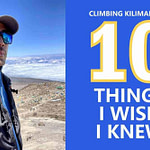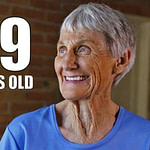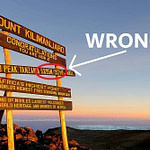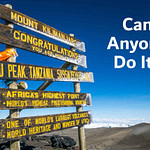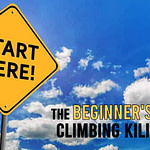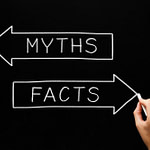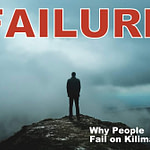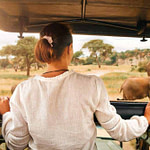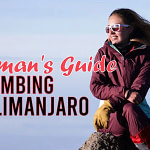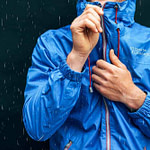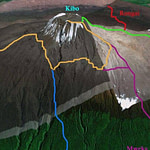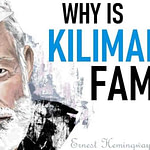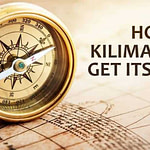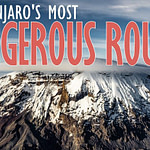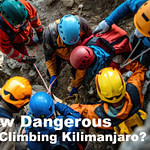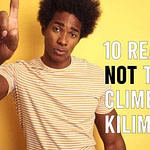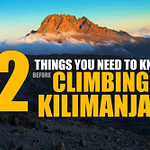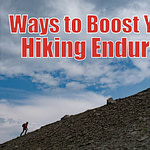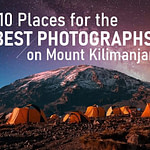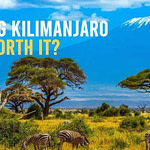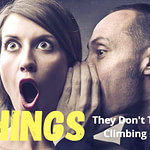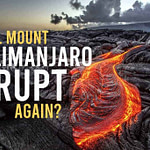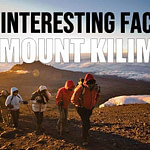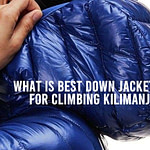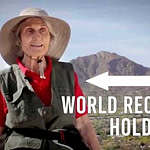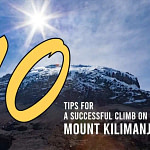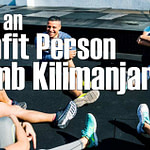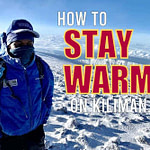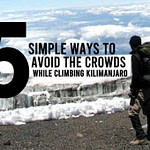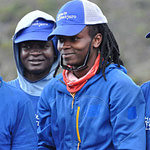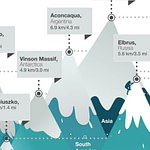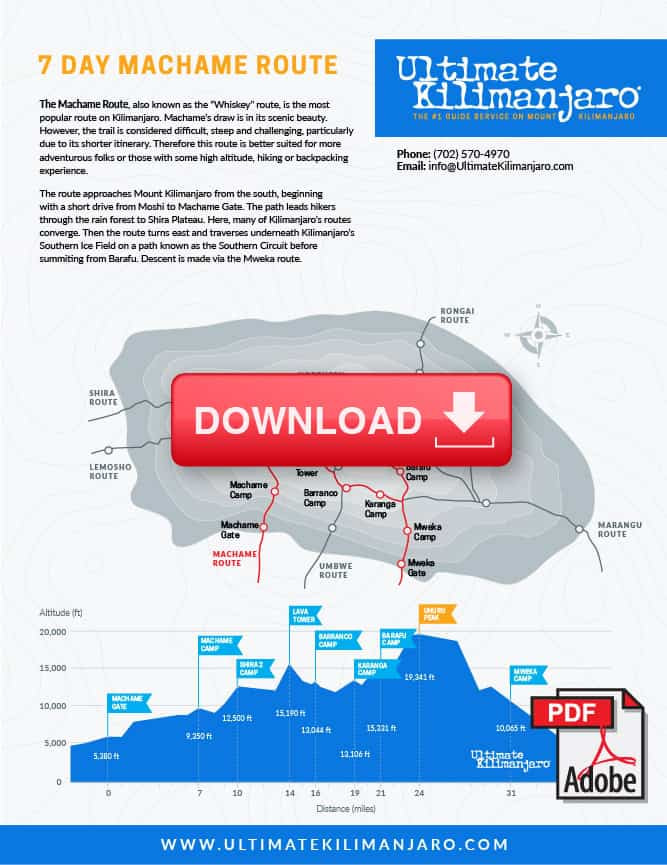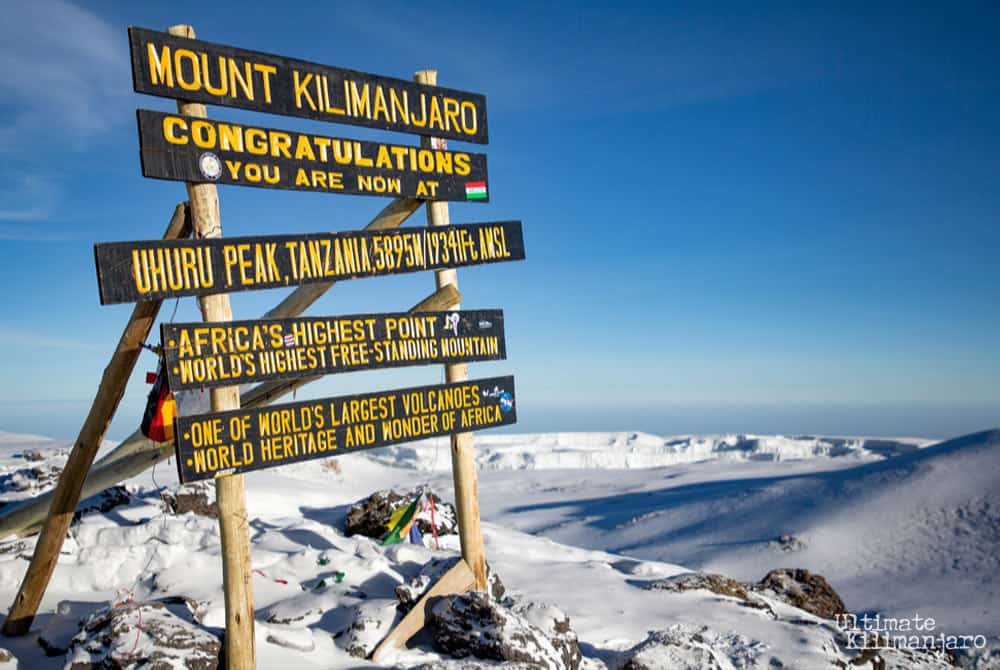
The Machame route, also known as the “Whiskey” route, is the most popular route on Kilimanjaro.
Machame’s draw is in its scenic beauty. However, the trail is considered difficult, steep and challenging, particularly due to its shorter itinerary. Therefore this route is better suited for more adventurous folks or those with some high altitude, hiking or backpacking experience.
The route approaches Mount Kilimanjaro from the south, beginning with a short drive from Moshi to Machame Gate. The path leads hikers through the rain forest to Shira Plateau. Here, many of Kilimanjaro’s routes converge. Then the route turns east and traverses underneath Kilimanjaro’s Southern Ice Field on a path known as the Southern Circuit before summiting from Barafu. Descent is made via the Mweka route.
Ultimate Kilimanjaro® offers Machame as a 7 day group climb or as a 6 to 8 day private climb.
- The 7 day Machame route is the standard itinerary and is described in detail below.
- The 6 day Machame variation cuts one day off the standard itinerary by combining days 4 and 5, going from Barranco Camp to Barafu Camp without staying at Karanga.
- The 8 day Machame “daytime summit” route shortens the summit day by beginning the summit bid in the daytime and returning and staying at Barafu Camp (instead of going to Mweka Camp). This variation eliminates the midnight summit attempt, which is typically very cold and windy, but uses an additional day to complete the descent. You can read more about this route here.
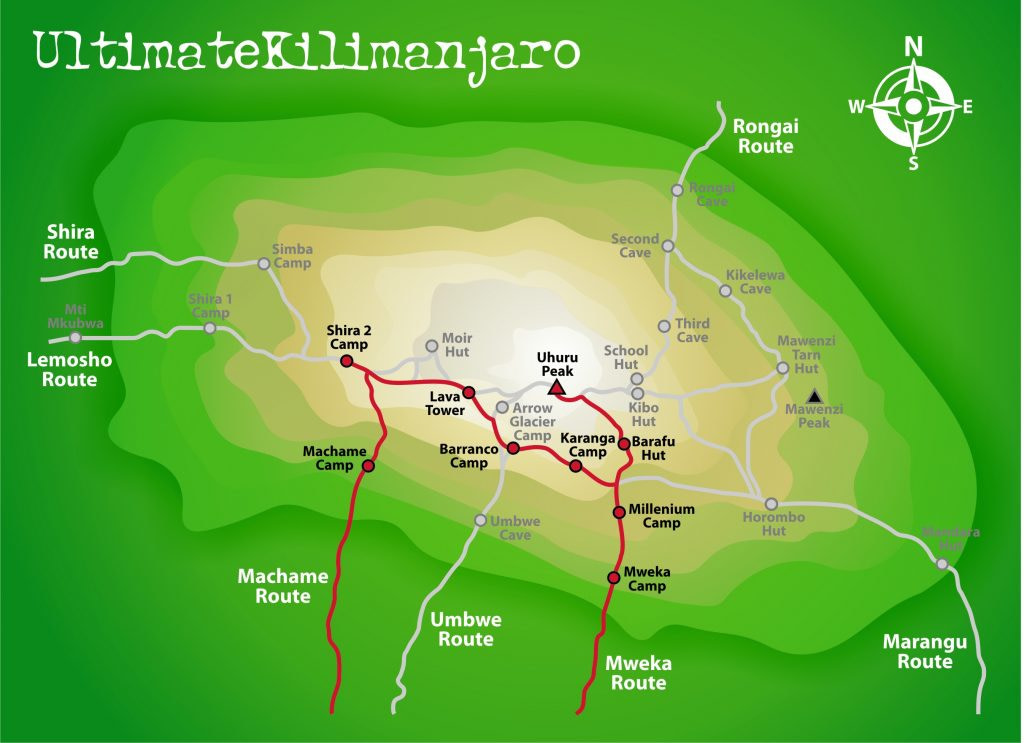
How Long is the Machame Route?
The distance of the Machame route is approximately 62 km or 37 miles. The total elevation gain ranges from approximately 16,000 to 17,000 feet.
How Many Days Does it Take to Climb Kilimanjaro on the Machame Route?
The Machame route has a few variations and can be completed in 6 to 8 days.
How Hard is it to Climb Kilimanjaro on the Machame Route?
The Machame route is considered a challenging route due to its distance and elevation gain. The up and down nature of the trail is strenuous. However, it does have a decent acclimatization schedule, which makes it a moderately difficult route.
What is the Success Rate of Climbing Kilimanjaro on the Machame Route?
The success rate depends on the number of days you spend on the mountain. For all operators combined, it is estimated that 6 day Machame climbs have a success rate of about 50% and 7 day Machame climbs have a success rate of around 70%. Our 6 day Machame route has a success rate of approximately 70-75% and our 7 and 8 day Machame route has a success rate of approximately 85-90%.
How Much Does it Cost to Climb Kilimanjaro on the Machame Route?
The cost of the Machame route will depend on the number of days. Our current pricing for a group climb on the 7 day Machame route is $2,799 per person. See all of our prices here.
7 DAY MACHAME ITINERARY
DAY 1 – Machame Gate to Machame Camp
Elevation: 5,380 ft to 9,350 ft
Hiking Time: 5-7 hours
Distance: 11 km | 7 miles
Habitat: Rain Forest
The drive from Moshi to the Machame Gate takes about 50 minutes. The journey passes through the village of Machame which is located on the lower slopes of the mountain. As we leave the park gate, we walk through the dense rain forest on a winding trail up a ridge until we reach the Machame Camp.
DAY 2 – Machame Camp to Shira 2 Camp
Elevation: 9,350 ft to 12,500 ft
Hiking Time: 4-6 hours
Distance: 5 km | 3 miles
Habitat: Heath
We leave the glades of the rain forest and continue on an ascending path up to a steep, rocky ridge. On the Shira Plateau, we pass through heather and open moorlands, then cross a large river gorge to Shira 2 Camp.
DAY 3 – Shira 2 Camp to Lava Tower to Barranco Camp
Shira 2 Camp to Lava Tower
Elevation: 12,500 ft to 15,190 ft
Hiking Time: 4-5 hours
Lava Tower to Barranco Camp
Elevation: 15,190 ft to 13,044 ft
Hiking Time: 2-3 hours
.
Distance: 7 km | 4 miles
Habitat: Alpine Desert
.
Distance: 3 km | 2 miles
Habitat: Alpine Desert
We continue to the east up a ridge and then head southeast towards the Lava Tower – a 300 ft tall volcanic rock formation. We descend down to Barranco Camp through the strange but beautiful Senecio Forest to an altitude of 13,000 ft. Although you begin and end the day at the same elevation, the time spent at higher altitude is very beneficial for acclimatization.
DAY 4 – Barranco Camp to Karanga Camp
Elevation: 13,044 ft to 13,106 ft
Hiking Time: 4-5 hours
Distance: 5 km | 3 miles
Habitat: Alpine Desert
We begin the day by descending into a ravine to the base of the Great Barranco Wall. Then we climb the non-technical but steep, nearly 900 ft cliff. From the top of the Barranco Wall we cross a series of hills and valleys until we descend sharply into Karanga Valley. One more steep climb up leads us to Karanga Camp. This is a shorter day meant for acclimatization.
DAY 5 – Karanga Camp to Barafu Camp
Elevation: 13,106 ft to 15,331 ft
Hiking Time: 4-5 hours
Distance: 4 km | 2 miles
Habitat: Alpine Desert
We leave Karanga and hit the junction which connects with the Mweka Trail. We continue up to the rocky section to Barafu Hut. At this point, you have completed the Southern Circuit, which offers views of the summit from many different angles. Here we make camp, rest and enjoy an early dinner to prepare for the summit day. The two peaks of Mawenzi and Kibo are viewable from this position.
DAY 6 – Barafu Camp to Uhuru Peak to Mweka Camp
Barafu Camp to Uhuru Peak
Elevation: 15,331 ft to 19,341 ft
Hiking Time: 6-8 hours
Uhuru Peak to Mweka Camp
Elevation: 19,341 ft to 10,065 ft
Hiking Time: 4-6 hours
.
Distance: 5 km | 3 miles
Habitat: Arctic
.
Distance: 12 km | 7 miles
Habitat: Rain Forest
Very early in the morning (around midnight), we begin our push to the summit. This is the most mentally and physically challenging portion of the trek. The wind and cold at this elevation and time of day can be extreme. We ascend in the darkness for several hours while taking frequent, but short, breaks. Near Stella Point (18,900 ft), you will be rewarded with the most magnificent sunrise you are ever likely to see coming over Mawenzi Peak. Finally, we arrive at Uhuru Peak– the highest point on Mount Kilimanjaro and the continent of Africa.
From the summit, we now make our descent continuing straight down to the Mweka Hut camp site, stopping at Barafu for lunch. The trail is very rocky and can be quite hard on the knees; trekking poles are helpful. Mweka Camp is situated in the upper forest and mist or rain can be expected in the late afternoon. Later in the evening, we enjoy our last dinner on the mountain and a well-earned sleep.
DAY 7 – Mweka Camp to Mweka Gate
Elevation: 10,065 ft to 5,380 ft
Hiking Time: 3-4 hours
Distance: 10 km | 6 miles
Habitat: Rain Forest
On our last day, we continue the descent to Mweka Gate and collect the summit certificates. At lower elevations, it can be wet and muddy. A vehicle will meet us at Mweka Village to drive us back to the hotel in Moshi.
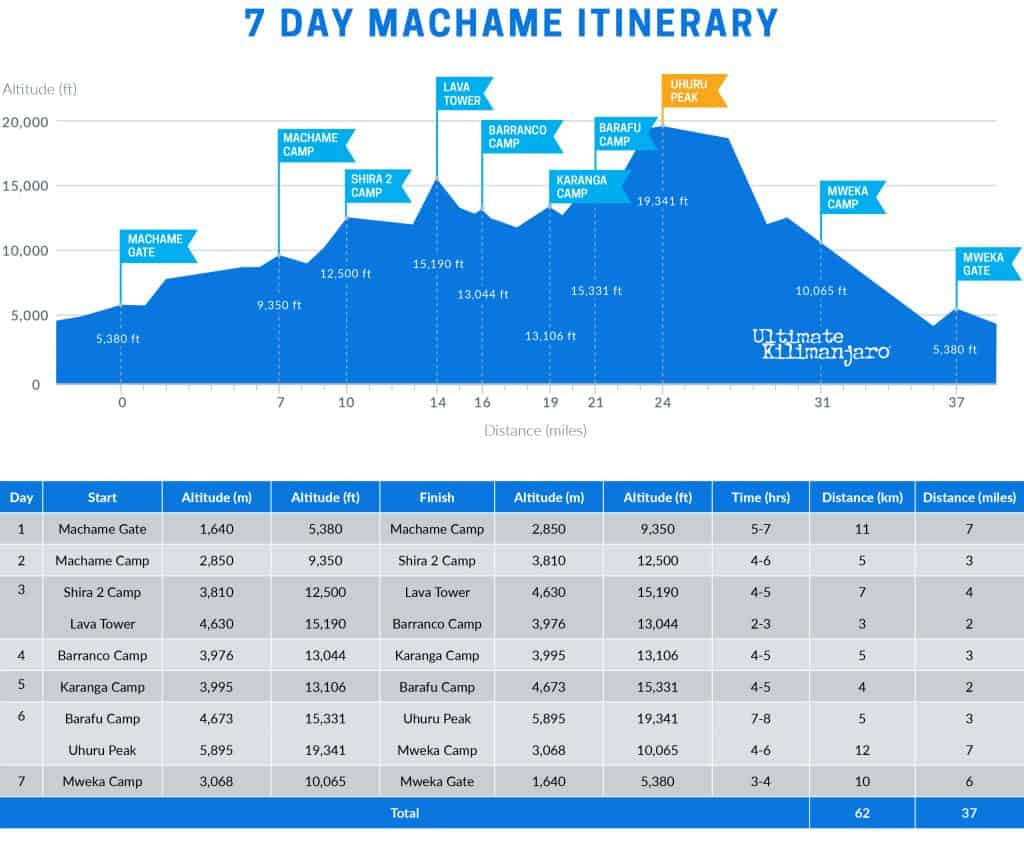
HOW TO CLIMB KILIMANJARO
1. How do I choose a good Kilimanjaro tour operator?
There are hundreds of companies who service the mountain, but only a handful can be considered reputable. Look for an established company with experienced and competent guides who practice high safety standards. Look for a tour operator that has proven expertise, successfully serving a wide range of clients spanning many years. Ultimate Kilimanjaro® has guided more than 15,000 clients to the summit since we began more than 18 years ago. We are the Kilimanjaro specialists. And we’re still going strong. read more>>
2. How much does it cost to climb Kilimanjaro?
Do not select a company strictly based on price! Price should be only one component in your overall decision. Prices vary significantly between operators, however high prices and low prices should both be viewed with caution. Ultimate Kilimanjaro® offers high quality climbs at reasonable rates. At our price levels, we can satisfy all park fees, pay real wages to staff, supply good food and equipment, while still providing great service to our clients, equal or better than climbs costing much more. read more>>
3. When is the best time to climb?
The best months tend to be the warmest and driest months – January, February, and September. June, July, August and October are also good months. However, temperatures and weather are unpredictable, and can change drastically based on the time of day and altitude. For most people, it’s best to avoid the long rainy season, from the end of March to early June, and the short rainy season, from November through the beginning of December. read more>>
4. Which is the best route for climbing Kilimanjaro?
Each route has different characteristics that may or may not appeal to you. Consider the difficulty, scenery and crowds when you select your route. Other factors that should be considered are your age, fitness level, medical conditions, backpacking and hiking experience, experience at high altitude, degree of motivation, and any other special considerations. Ultimate Kilimanjaro® recommends the Northern Circuit, Lemosho, Machame and Rongai routes. Which is best depends on your specific situation. read more>>
5. How long does it take?
The more days that you spend on the mountain, the higher your chances of reaching the summit. Statistics show that each additional day you spend acclimatizing increases your probability of success. Therefore we strongly recommend that you do not book the minimum number of days. Odds are you will experience altitude sickness, won’t enjoy your hike, and won’t reach the top. Seven or more days is highly recommended for a safe and successful climb. Our 8 and 9 day routes are the most popular. read more>>
6. What is the weather like on Kilimanjaro?
Mount Kilimanjaro does not experience wide temperature changes from season to season. Instead, the temperatures are determined more so by the altitude and time of day. The trek from base to summit crosses several distinct climate zones, each with different temperatures, humidity, and precipitation levels. On the lower slopes, the average temperature is around 70 to 80F (21 to 27C) and decreases as you gain elevation. At the top, night time temperatures can range between 20 to -20F (-7 to -29C). read more>>
7. What gear do I need?
You are responsible for bringing personal gear and equipment while communal equipment (tents, food, cooking items, etc.) is provided. Our comprehensive gear list contains everything you need to tackle the mountain’s varied terrain and weather. It includes technical clothing such as a waterproof jacket, insulated jacket and base layers as well as equipment such as a backpack and sleeping bag. Note that you will only carry a small daypack with you while you hike between camps. The remainder of your gear is transported by our support crew. No need to carry heavy packs! read more>>
8. How do I train to climb Kilimanjaro?
It is very hard to gauge the mental and physical strength needed for tackling the peak. If you’ve spoken to those who have successfully or unsuccessfully climbed it, you’d get a wide range of accounts. The truth is, like any other activity, some people excel at it and some people struggle. We recommend a minimum of two months of physical training – more if you are out of shape, less if you are already an avid hiker. The best exercise is doing day hikes for four to six hours, with moderate elevation changes (~1,500 ft), while carrying a 20 lb. pack. Endurance is key, so focus on long sessions at a slow pace. read more>>
9. Is climbing Kilimanjaro dangerous?
Ultimate Kilimanjaro® has robust safety systems in place to minimize the dangers of high altitude trekking. Our guides are certified Wilderness First Responders. We perform health checks twice per day to monitor oxygen saturation levels and pulse rate. Additionally the Lake Louise Scoring System helps us determine whether climbers have altitude sickness and if so, its severity. Bottled oxygen is carried on every climb as a precaution and added safety measure. We can even initiate helicopter rescue if necessary. Your health and well being is our first priority and we take that responsibility very seriously. read more>>
10. Why are some company’s prices so low?
There is a fair share of budget tour operators who offer cheap climbs. These poorly run companies use low prices as their only way to attract clients. There is simply no way for these tour operators to provide satisfactory services without skimping on necessary expenditures that affect the quality of your climb. For starters, they have low level guides (top guides don’t work for budget companies), questionable equipment, and serve nutrient deficient meals. Furthermore, they engage in appalling practices such as paying paltry wages, underfeeding staff, and forcing porters to carry loads greater than the weight limit. Never climb with a budget operator. read more>>


